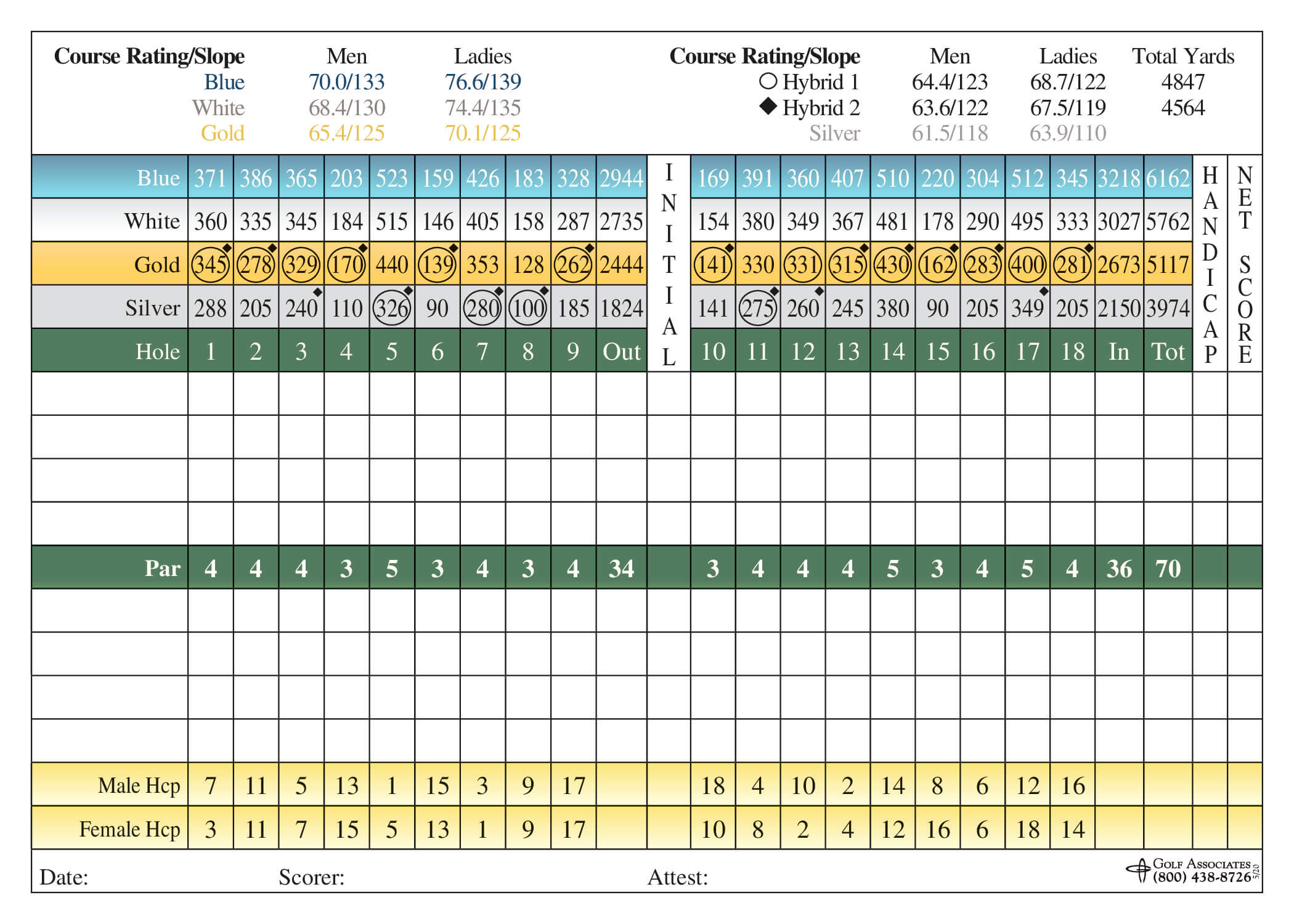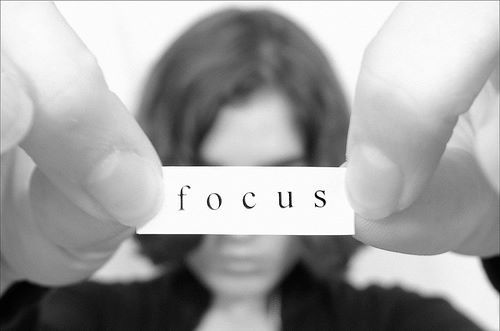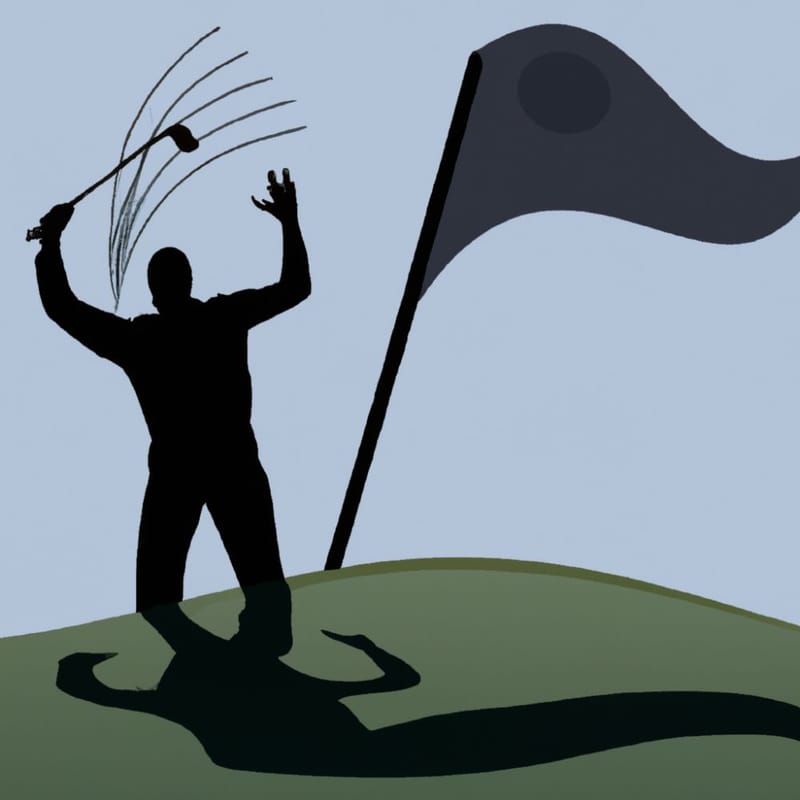Content Summary
How to break 100 in golf is a common question for many beginner and intermediate golfers.
It may seem like a daunting task, but with the right approach, it can be achieved.
My reward for breaking 100 the first time was a signed deal with a customer I was trying to do business with.
He said my determination and persistence to break 100 made him believe I would be the same way in making sure the deal we signed would be followed through on and completed as agreed. Needless to say there were other signed deals after that.
This is probably a good time to take a minute and explain how I got into playing golf in the first place. You see, I used to be a fisherman.
Even owned a 20ft boat geared for fishing the ocean, bay and rivers. I would also charter a commercial boat every year to chase after those elusive salmon. I would invite customers and then employees and then friends depending on space availability.
The first few years went pretty well but then it started to taper off with many customers bowing out. Having to get up early enough to meet the boat at 6am and then spending a day rocking back and forth caused all but the most hardy to want to take on the challenge.
That's when one particular customer suggested I try golf since it was more conducive to talking business without all the distractions.
I took him up on it and fell in love with the challenge. I remember watching PGA golf tournaments and saying, 'man I can hit that little white ball, easy peasy, no problem'. Well, it's not quite as easy when you're out there actually trying to hit that ball.
Those pros made it look so easy. Taking up golf caused three things happen, 1. I gave my boat away to my best friend, 2. My wife was not a happy camper since she no longer had fresh fish in the freezer and 3. It was great for business.
So, with that said, I want to try and help those who are struggling with their game today with this comprehensive guide on how to break 100 in golf.
Break 100 in golf: The approach
The first step if you want to break 100 in golf is developing a plan. To do this, you must identify your strengths and weaknesses as a golfer.
Are you strong off the tee? Do you struggle with your short game? Do you have a good putting stroke? By identifying your strengths and weaknesses, you can create an approach to playing golf that accentuates your strengths and minimizes your weaknesses.
Once you have identified your strengths and weaknesses, the next step is to come up with a plan for each hole.
Your plan will evolve as you play the hole but you want to be thinking about how long you hit your tee shots, how far you hit your irons, and what clubs you typically use.
You should also take into consideration the length of your approach shot, the difficulty of your chip shot, and the length of your putt.
As you're working you're plan think about what your goal is on that particular hole. Is it to shoot a good score? Is it to gain strokes on the other players? Is it to shoot even par or to field test your new swing or putting stroke? The goal you select will affect your choice of shots.
Scoring Considerations
When it comes to golf, scoring considerations are crucial in breaking through the 100 barrier. One of the most important factors when trying to achieve a low score is accuracy.
It's essential to aim for the middle of the fairway on every shot and keep your ball in play, as hitting into hazards or losing balls can result in penalty strokes that add up quickly.
Another key factor is course management. Understanding your own strengths and weaknesses and playing strategically around them can help you avoid unnecessary mistakes.
This means choosing sensible shots instead of always going for the longest or most challenging option, as well as knowing when to lay up rather than taking risks that could lead to trouble.
Finally, consistency is vital in achieving a good score. This includes having a reliable swing and being able to replicate it consistently on each shot.
It also means avoiding mental errors like rushing shots or getting too frustrated after bad shots, which can lead to even more mistakes down the line. Remember, every hole is a new opportunity for par.
By focusing on accuracy, course management, and consistency, golfers can increase their chances of breaking 100 in golf and achieving their best scores yet.
Course Strategy
The first step in developing a successful course strategy is determining the number of strokes you want to make. This requires analyzing your skills and abilities and setting realistic goals for improvement.
It's important to be honest with yourself about your current strengths and weaknesses, so you can focus your efforts on areas that will have the greatest impact.
Once you've determined your target score, you can start planning your approach to each hole. This involves considering factors such as distance, hazards, wind direction, and pin placement.
You'll need to decide which clubs to use off the tee, where to aim your shots, and how aggressively or conservatively to play each hole.
To develop a winning course strategy in golf, it is essential to understand where you are as a player. While some players excel at hitting long drives, others may be more proficient with their short game. By identifying these areas of proficiency, you can tailor your strategy to suit your playing style.

Layout of the Land
Another aspect of course strategy is understanding the layout of the course itself. Familiarizing yourself with the terrain, hazards, and green speeds can help you make informed decisions about club selection and shot placement.
Paying attention to wind conditions and weather patterns can give you an added advantage on the course.
Ultimately, a solid course strategy requires patience and adaptability. Even the best plans can go awry when unexpected obstacles arise during gameplay.
Being able to adjust your approach on the fly will allow you to stay competitive throughout your round and increase your chances of success on every hole.
Ultimately, the key to breaking through the 100 barrier in golf is a combination of physical skill and mental toughness.
By setting clear goals for yourself and developing a solid course strategy based on those goals, you'll give yourself the best chance of success on every shot. With practice and perseverance, you can achieve lower scores than ever before!
Equipment
It is essential to have the right equipment. Golf clubs, golf balls, golf shoes, accessories and even clothing can all make a difference in your game. Start by investing in a good set of clubs that suit your height, swing speed, and skill level.
Next, find a ball that works well for your swing and skill level. Shoes that offer good traction and support are also important. Accessories that allow you to clean your balls and clubs and fix divots on the green help you stay focused on the task at hand.
Investing in the right equipment is paramount when it comes to golfing. Choosing the right clubs can significantly impact your game.
Ensure that you have a putter, driver, irons, and wedges in your set, as they are essential for different shots.
I can't tell you how often I see players using the wrong club for a shot simply because they don't carry the right clubs in their golf bag. The weight and length of each club should be comfortable for you to swing naturally.
Balls are equally important in golf. Golf balls come with different features such as spin rate, compression level, and softness or hardness of the cover material.
Each of these factors affects how far or straight the ball flies after being hit with a club. For example, high-compression balls require more force from faster swings to achieve maximum distance.
Footwear is crucial when playing golf since it helps maintain balance on the course's undulating terrain. Golf shoes offer specialized soles designed to grip well on grass while providing ample support during swings. Sore feet affect your concentration.
They also come with waterproof materials that keep feet dry even during rainy days on wet golf courses. With proper golf clothing that keeps you comfortable throughout your game regardless of weather conditions will undoubtedly make a big difference too!
Accessories such as towels, brushes, divot tools, tees, ball markers are all essential in being prepared to play your next shot quickly and efficiently.
Stance
The stance is an essential part of your golf swing. It provides the foundation for balance, power, and consistency in your shots.
Start by positioning your feet shoulder-width apart and aligning your body parallel to the target line. This will provide your ball with the best chance of starting on the proper target line.
Ball position will be dependent on club selection:
For wedges and short irons the ball will be placed closer to the center of your stance and gradually move left (for right handed golfers) as your clubs get longer.
Except for the driver all clubs should hit down on the ball for best compression and distance.
Your weight should be evenly distributed between both feet, with slightly more weight on your left foot if you are right-handed and vice versa for left-handed players.
Your knees should be slightly flexed to create a stable base, while keeping your back straight and shoulders relaxed.
A proper stance not only helps improve your swing but also minimizes the risk of injury by reducing stress on your joints.
Take some time to practice and find what works best for you. With a solid foundation, you'll be well on your way to breaking through that 100 barrier!
Swing
Golf is a game of skill that requires both physical and mental discipline. Every golfer wants to make the perfect swing, but it’s not always easy to achieve.
The swing is where the magic happens, and it all starts with gripping the club correctly. Start by gripping the club with both hands, with the clubface square to the target.
The V's created by the forefinger and thumb of both your hands should point to your right shoulder for right hand golfers. Keep your back straight and angled at about 30 degrees with your your eyes on the ball.
The backswing should be smooth and controlled keeping the club head inside your hands, with a slight pause at the top focus on shifting your weight to your front foot and rotating your hips towards the target then drop your arms instead of pulling them towards the ball which will cause you to come over the top.
By rotating your hips first your arms will be in the right position to power through the ball. Follow through with a smooth finish.
Remember that golf is a game of practice and patience; there are no shortcuts to becoming an excellent player.
Consistent practice enables you to identify areas in which you need improvement while building up confidence in yourself and honing your skills over time.
With these tips in mind, anyone can learn how to smash through the 100 barrier in golf! So keep practicing until every shot feels like magic!

Practice
The right practice makes perfect. Practicing your swing is essential to improving your golf game. It's not enough to hit the range and swing aimlessly or just play a round of golf without any intention of improving.
You must dedicate time to practice with purpose, working on developing a consistent swing that you can rely on during every round. There are plenty of tools available to help you improve your swing.
Swing analyzers, golf swing training clubs, grip trainers, impact bags, etc. Dedicate time to practice your swing the right way, both on the range and on the course.
Focus on developing a consistent swing and mastering the fundamentals. You can also practice your short game by chipping and putting on the practice green.
To start, it's important to begin by understanding proper technique and form in your swing. Once you have a solid foundation, focus on building muscle memory through repetition and consistency.
Practice both on the range and on the course, hitting different shots from different lies to simulate real-world scenarios. You may also want to get a swing coach. Someone who can step you through a progression so you are building on your swing in the proper way.
Some coaches will even go out with you for a few holes to help you bring the coaching to the course under real playing conditions.
It's also important to track progress over time, noting areas for improvement and celebrating small victories along the way.
Remember that mastering your swing takes time, patience, and dedication but with consistent practice, you'll soon see results in lowering your score and smashing through the 100 barrier in golf!
Exercise
Golf requires a certain level of fitness. Engage in regular exercise to improve your overall fitness level and prevent injury. Focus on building strength and flexibility, especially in your core and lower body.
One of the biggest misconceptions about golf is that it's a game played by retirees and people who are not particularly athletic. However, golf requires a certain level of fitness, especially if you want to consistently perform at your best and avoid injury.
Engaging in regular exercise can help improve your overall fitness level, which will have a positive impact on your game.
Golf Specific Exercises
When it comes to golf-specific exercises, focus on building strength in your core, legs and upper body. This will help you generate more power with your swing and maintain good posture throughout the round.
Improving flexibility through stretching or yoga can also aid in preventing injury. Use a golf fitness tracker. There are many different fitness trackers on the market today that can help you improve your golf game.
A good example is the FitBit Blaze, which offers a variety of different features for tracking your activity levels and progress over time. You can check it out here on Amazon.
Overall, incorporating exercise into your routine can have significant benefits for both your health and golf game. By committing to regular physical activity focused on building strength and flexibility, you'll be well-equipped to smash through the 100 barrier in golf!

Focus
Golf requires mental focus and concentration. Visualize the shot before taking it, and trust your swing. It's not just about hitting the ball as hard as you can, but also about staying focused on the shot at hand.
One of the most important things to remember when playing golf is to avoid getting ahead of yourself. This means not thinking too much about your next shot or worrying about how many strokes you need to take to get to the green.
Instead, take each shot one step at a time and focus on what you need to do in that moment. Visualize the shot before taking it and try to block out any distractions around you.
If your mind starts wandering or if negative thoughts begin creeping in, take a deep breath and refocus on your game plan.
By staying mentally focused throughout your game, you'll be able to make better decisions, stay more composed under pressure, and ultimately improve your scorecard.
Remember: golf is as much a mental game as it is physical – so stay sharp and keep pushing through those barriers!

Mental Aspects of the Game
Golf is widely considered as a game of precision and skill. However, many golfers overlook the mental aspect of the game which can be just as important, if not more so.
Golfers must learn to manage their emotions, stay focused and mentally tough throughout the entire game. Any negative thoughts or feelings can throw off a golfer's balance and lead to poor shots.
In order to develop strong mental fortitude in golf, it is critical for players to learn how to manage their stress levels.
This means finding ways to remain calm and centered under pressure. Furthermore, visualization techniques are also essential in assisting players in visualizing successful shots before they even take them.
Ultimately, the mental aspect of golf requires discipline and practice just like any other part of the game. The more effort golfers put into mastering this area, the more likely they are to achieve success on the greens by smashing through that elusive 100 barrier!
Putting
Putting is often the difference between breaking 100 and falling short. This is where I find most high handicappers lacking. There is no consistency to their putting stroke, it changes from hole to hole. The first thing you need to do is get a putting routine down. This means learning how to make a proper putting stroke.
The idea is to use a rocking motion with your shoulders and arms, almost like a pendulum, back and forth, while keeping your head still. You can follow the ball with your eyes but if you lift your head to peek you'll throw the pendulum off. This also allows you to better control speed. Perfect practice makes perfect.
Good lag putting will save you more strokes than you can imagine. How many times have you putted 10 feet past the hole only to miss the next putt back causing a 3 putt or worse? Once you save a few pars your confidence grows and you'll be closer to cracking the 100 barrier.

Style of Putter
Depending on your putter which can be face balanced, toe balanced or heel balanced your stroke will either be straight back and through or an arching stroke.
If you don't know what type of putter style you have , ask a fellow experienced golfer, your coach or go to your local golf store and inquire there. It's important to know what type of putter you have if you're going to improve.
Then learn how to judge and control putting distance. Learn to read the green and determine the slope and speed. This will give you an idea of how hard to hit the ball and in which direction. Once you have assessed the green, take a few practice putts to get a feel for it.
Pay attention to how far your ball goes with each stroke so that you can adjust accordingly. The stroke should be smooth and controlled, with a slight follow-through.
Another essential aspect of putting is to maintain a consistent stroke throughout the game. Avoid muscle tension and focus on keeping your arms loose, allowing for a smooth swing back and through.
Practice the Bump and Run Chipping
The bump and run chipping technique is a common strategy used in golf to get the ball closer to the hole. This chip shots requires minimal air time and maximum roll on the green, making it an effective way to save strokes.
To achieve this shot, you need to use a wedge with a low degree of loft. You can even use your 9, 8 or 7 iron if you are more comfortable with one of these clubs.
To practice this technique, determine where you want the ball to land on the green and mark that spot then use your preferred club and try to hit that spot consistently.
Once you can do this start moving the marker around to emulate spots on the greens you will be playing out on the course so when you encounter a shot like this while playing you will have the confidence to pull it off.
Pitching Wedge
Most golfers want to fly the ball to the hole but don't fall into this trap. It is too difficult to judge the proper distance and then get the ball stopping next to the hole.
It will usually role farther past the hole and may cause you to have to three putt which reduces your chances of breaking 100.
However, pitch shots are a good choice when you need to clear hazards and get onto the green but you need to practice this shot to make it pay off. It will tend to leave you farther from the hole than a bump and run chip but with your new putting skills you should be ok.
Focus on your stance and grip while practicing this move. Keep your feet close together and weight slightly forward towards the target.
Choke down on the club for better control of your swing. With enough practice, you can master this shot along with the bump and run chip.
Below is a great video on how to properly chip.
Work out the Distance You Hit Each Club
Another issue I see with high handicappers is they don't really know how far they hit each club. They think they hit their 7 iron 150 yards when in reality they hit it 135 yards.
They come up short of the green and wonder what went wrong. To smash through the 100 barrier in golf, you need to work on your distance control. One effective way to do this is by understanding how far you hit each club in your bag.
Knowing the exact distances of each club can help you make better decisions on the course and improve your overall performance. Remember, balls on the practice range do not fly as far as your regular golf ball.
They are built for taking a daily beating on the range and not so much for accurate distances. In speaking with the pro at our local golf range he indicated the balls may fly 8-10 yards shorter, so keep this in mind.
Use GPS To Improve
To work out the distance you hit each club, head to a driving range with some markers or use a golf GPS app that can measure your shots (some ranges now utilize GPS units for each practice bay so you can practice with more precision).
Start with your shortest club, usually a wedge, and take several swings while noting how far the ball travels. Repeat this process for all clubs in your bag until you have an accurate yardage for each one.
Once you have determined the average distance for each club, create a chart or note them down in a notebook that you can refer to during practice rounds and tournaments.
With this information at hand, you'll know which club to use for certain shots and reduce the likelihood of hitting short or long of target greens.
Use Hybrids Instead of Long Irons
Oftentimes when we are starting out in golf we are the recipients of someone else's previously used clubs.
These sets of older clubs may come along with long irons such as 5, 4 and 3 irons. Personally, I don't use anything higher than a 4 iron but don't suggest for beginners to hit anything higher than a 6 iron.
It is best to replace the 4 & 5 with a hybrid and just store the 3 iron away. Hybrids are becoming more and more popular in the game of golf, and for good reason.
They are a great alternative to long irons because they have a larger clubface and lower center of gravity, which makes them easier to hit. Hybrids also tend to be more forgiving on mis-hits compared to long irons. A hybrid will quickly become your reliable club.
Struggling With Your Long Irons
As mentioned above and I think it needs repeating, if you're struggling with your long iron shots and consistently coming up short or off target, it may be time to consider switching to hybrids.
They can help improve your accuracy and distance on longer shots, ultimately leading to better scores on the course.
It's important to note that not all hybrids are created equal. It's best to test out different brands and models before making a purchase, as some may suit your swing better than others.
Don't be afraid to seek advice from a professional or experienced golfer when making this decision.
Par 3's
If you want to improve your score. Improve your play on par 3's. Par 3's are an essential part of any golf course, and they can often be the most challenging holes to play.
These holes require precision and accuracy, as well as a good understanding of the wind and other conditions that can affect your shot.
To master par 3's, it is important to practice your short game regularly. This includes working on your chipping, pitching, and putting skills so that you can make the most out of every opportunity.
One key strategy for playing par 3's is to focus on getting your ball onto the green in one shot. This will give you a good chance of making a birdie or par, while also avoiding any potential hazards around the hole.
It is also important to choose the right club for each particular hole based on its length and any obstacles in your way.
Another tip for mastering par 3's is to stay calm under pressure. These holes can be particularly nerve-wracking because they are often shorter than other holes but require more accuracy.
Take deep breaths before each shot and focus on executing a smooth swing with good technique rather than worrying about where the ball will end up.
Long Par4's
Long par 4's can be intimidating for golfers of all levels, but they don't have to be. The key to success on these holes is strategy and execution.
To break 100 it is best to play these holes as a par 5. For some reason when high handicap players try to par a longer par 4 they tend to make a double bogey or worse.
If you play it as a par 5 the pressure will be off and you should come away with no more than a bogey or at worse a double bogey which still keeps you in the hunt for breaking 100. Approach shots are key here so take your time, assess the shot and then execute it.
First and foremost, it's crucial to assess the distance and terrain of the hole before taking your shot. This will help you determine the best club to use off the tee and enable you to position yourself for a successful second shot.
Once you've landed your tee shot, it's important not to get too aggressive with your second shot. Instead, focus on accuracy over distance and aim for the center of the fairway or putting green. This will give you a better chance at making par or at least minimizing any potential damage if things go awry.
Finally, when putting on long par 4's, it can be helpful to imagine breaking up the putt into smaller sections rather than trying to sink it all in one go.
By focusing on getting close enough for an easy tap-in rather than trying to make a long putt, you'll increase your chances of successfully navigating these challenging holes.
Par 5's
Needless to say, this is a hole you will want to play as a par 6. Again, when you know you have a smidge more room for error you will play more relaxed and make better swings because of it.
This could be your magic hole. The one where you can actually pull off a birdie if the stars align just right. And if you remember your astronomy class, the stars do align just right every so often.
You will want to keep your tee shot on the fairway so hit a 3 wood if you are struggling with your driver on this particular day. It will provide you with a better chance to hit straight shots.
Don't try to cream the ball, a nice smooth swing will keep you on the fairway and result in good distance. You have 3 more shots to get on the green and then 2 putts for your bogey or par or birdie depending on how well you did with your previous shots.
A. Don't Focus on the Score
One of the most common mistakes that golfers make when trying to improve their game is worrying about their score.
While it's important to keep track of your progress, focusing too much on your score can actually hinder your performance.
Of course, this doesn't mean that you should completely ignore your score altogether. Keeping track of how many strokes it takes you to complete a round can help identify areas where you need improvement.
B. Don't Obsess Over Your Score Either
The reason for this is simple: when you're fixated on achieving a certain number, you start to feel pressure and stress which can affect your swing and decision-making abilities.
Instead of obsessing over your score, try to focus on the process of playing golf. This means paying attention to each shot and making adjustments as needed.
For example, if you notice that you're consistently hitting the ball too far left or right, take some time to evaluate what might be causing this problem and adjust accordingly.
By focusing on the process rather than the outcome, you'll be able to make gradual improvements in your game without feeling overwhelmed by expectations.
FAQ's
What percentage of golfers can break 100?
It's been reported that a survey conducted by the National Golf Foundation in 2018 found roughly 50% of all golfers can break 100.
This is great news for those just starting out in the sport! Breaking 100 is a major milestone that many golfers strive to achieve.
It's an indication that you have a good understanding of the basics and can play with some consistency. With practice and dedication, you too can join this 50% of golfers who are able to break 100.
So don't get discouraged if it takes some time - just keep working hard and you'll be there before you know it!
How long should it take to break 100 in golf?
Breaking 100 in golf is a great accomplishment and estimates are that it can take a few months or even a couple years depending on the golfer's skill level and willingness to practice.
Generally speaking, it's best to set realistic goals and expectations for yourself when trying to break 100.
The most important thing to remember is that practice makes perfect. Set aside time each week to work on your game and practice different shots.
It's also helpful to get lessons from a professional golf instructor who can help you identify areas of improvement and develop an effective practice routine.
Finally, be patient with yourself and don't expect results overnight. Breaking 100 in golf requires dedication, focus, and discipline, so stay committed to the process and enjoy the journey!
How do you practice to break 100 in golf?
To reach this goal, review the above tips and focus on developing your technique and accuracy. Start by getting comfortable with the basics of your swing.
Practice hitting shots from different distances and angles to improve your muscle memory and accuracy.
Additionally, practice putting from all distances to get a feel for the green, as well as chipping around the greens to help you save strokes when you’re close to the pin.
Also, work on course management skills such as club selection and strategy. Knowing which club to use in various situations can help you avoid costly mistakes that will keep your score up.
Finally, set realistic goals for yourself while playing rounds of golf and track your progress over time to measure improvement.
With consistent practice and focus on improving your skills, breaking 100 in golf is within reach!
Bonus Question - Is 100 a decent golf score?
It depends on the context. A score of 100 is not considered a good score for a professional golfer, but it can be considered decent for most amateur golfers.
The average score for an amateur golfer is usually in the range of 90-110, so a score of 100 would be right in the middle.
If you are just starting out and learning the game, then a score of 100 is perfectly respectable and should not discourage you from continuing to practice and improve your skills.
As long as you continue to work hard and stay focused on your goals, you will eventually see improvement in your scores.
Conclusion
Try to keep this in mind, 9 bogeys and 9 double bogeys will have you finally break 100 in golf. Yes, breaking 100 in golf is no easy feat.
However, if you focus on improving your swing, practicing regularly, and playing with others who are better than you, you can make huge strides in your game. Remember to practice patience and keep a positive attitude.
With consistent hard work, you can break through this milestone and improve your score! So what are you waiting for? Get out there and start working towards achieving your golfing goals!
Thank you for visiting, and we hope to see you back soon!
Note: We use affiliate links and may receive a small commission on purchases at no additional cost to you.






